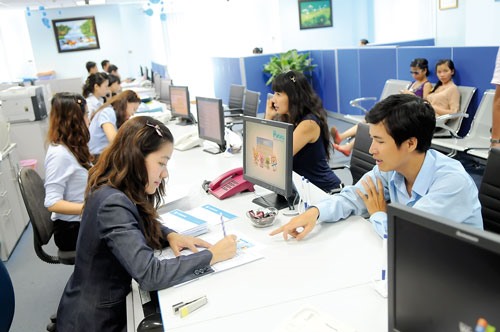 Economy
Economy

Nguyễn Thị Hồng, deputy governor of the State Bank of Việt Nam, said as of May end bank credit had grown at 6.58 per cent in the year-to-date, an eight-year high.
 |
| Customers borrow credit loans at a branch of Eximbank. — Photo chinhphu.vn |
Nguyễn Thị Hồng, deputy governor of the State Bank of Việt Nam, said as of May end bank credit had grown at 6.58 per cent in the year-to-date, an eight-year high.
The rate in the same period had been 5 per cent and 4.5 per cent in 2016 and 2015.
Many lenders such as ACB, Vietcombank, and LienVietPostBank have in fact reported growth rates of 8.3 per cent to 11 per cent.
Explaining the steep growth, market observers said in recent months domestic enterprises’ credit demand might have been higher since their production and trading activities have gradually picked up pace after major festivals, including Tết.
Circular No 39/2016/TT-NHNN which took effect in March, is one of the main reasons, they said.
It allows credit institutions, including banks, to reschedule debts based on a careful assessment of whether a customer has the capacity to fully repay the loan principal and /or interest within the rescheduled period.
Another important factor is the strong recovery by the real estate and stock markets.
What needs mentioning is that analysts are not happy at the strong credit growth: many are in fact concerned.
Pointing to the fact that economic growth this year has been lower than last year – though, technically, in an inefficient economy like Việt Nam, higher investment usually translates into higher growth – into ‘hot’ sectors like real estate and stocks.
According to the SBV branch in HCM City, loans outstanding by the real estate sector at the end of March was over VNĐ164 trillion (over US$7.22 billion), accounting for 10.88 per cent of total credit and 19.29 per cent of long- and medium-term loans. It had risen by 4 per cent from the end of 2016.
According to the Việt Nam Real Estate Association, investment in the real estate market rose by 43.8 per cent year-on-year in the first five months.
In recent years banks have also invested large amounts in build-operate-transfer (BOT) transport projects, accounting in fact for 85-90 per cent of the projects’ investment.
The Ministry of Transport also said that in the period of 2000 and June 2016, 45 transport projects that were put into operation had taken bank loans worth VNĐ94.17 trillion, which made up 85.3 per cent of their total investment.
The stock market has also seen a significant injection of money this year.
For instance, in May cash pumped into the market increased to VNĐ4 trillion ($176.2 million) a week, and even VNĐ6 trillion ($264.32 million) on occasions, up from an average of VNĐ2-3 trillion in the past.
Hồng however estimated that bank lending in the first five months was focused on industries prioritised by the Government such as agriculture, exports, supporting industries, small- and medium-sized enterprises (SMEs) and technology.
Besides controlling the lending to the real estate sector, the central bank has also instructed credit institutions to closely monitor loans to build-transfer (BT) and BOT projects, she said.
Though the bank said the credit flows have been well targeted, the rapid expansion of credit in the context of the high bad debt levels has made experts uneasy.
They said credit growth has shot up though policy rates have remained unchanged.
This expansion of credit – at a much higher rate than the nominal GDP growth rate – provides some cause for concern, particularly since Việt Nam’s credit-to-GDP ratio of around 120 per cent in December 2016 was already high and the overhang of past non-performing loans has not been fully resolved.
Analysts also warned of the danger of the economy becoming capital-intensive if the policy of achieving economic growth on the back of credit continues.
To lessen the risk, they said it is necessary to control credit flows as well as continue with the shifting away from the current capital- and natural resources- intensive GDP structure to manufacturing and trading.
In February US drug company Abbott Việt Nam said it would license Domesco Medical Import – Export Joint Stock Corporation Vietnam for production of 28 products in Việt Nam including 17 common and 11 cancer drugs.
Abbott will help Domesco build a factory in Đồng Tháp, provide technological support and consultancy as well as training, and help produce and trade the drugs in Việt Nam.
In September the US giant will send specialists to the Đồng Tháp plant to help improve the local firm’s capacity.
It has a 51.69 per cent stake in Domesco and its main focus is to build a non-batalactam plant to EU-GMP standards.
In August 2016 Abbott completed the acquisition of Glomed Pharmaceutical Company limited (Glomed), a leading Vietnamese drug manufacturer.
Through this, Abbott became one of the top 10 pharmaceutical companies (according to IMS data report Q2 2016) in Việt Nam.
In addition to obtaining two manufacturing facilities in Bình Dương Province, Abbott also gains a portfolio of medicines that is well aligned with its current pharmaceutical therapeutic areas of focus: anti-infective medicines, gastroenterology, cardiovascular, pain management, respiratory, and women’s health as well as over-the-counter products.
In September 2016 France’s Sanofi also signed an agreement to extend and strengthen its partnership with Vinapharm. The new strategic partnership covers all locally manufactured medicines marketed by Sanofi in Việt Nam and products exported to countries in the Asian region.
The agreement is expected to take effect by year-end subject to approval.
Vinapharm will invest in Sanofi Vietnam Shareholding Company, which owns a new, good manufacturing practices-certified facility.
The US$75 million plant will not only produce 150 million batches of drugs per year but also be a centre of excellence in Asia. It constitutes Sanofi’s largest investment in any ASEAN member country to date.
Last July Japan’s Taisho Pharmaceutical Holdings, part of the Taisho Holdings Group, completed necessary procedures to buy a 24.5 per cent stake in the Hậu Giang Pharmeuctical Company.
Analysts attributed the surge in mergers and acquisitions in the pharmaceutical industry to the industry’s great potential.
The Vietnamese pharmaceutical market is one of the fastest growing in Asia. It ranked 17th in the world with average growth of 17-20 per cent a year between 2010 and 2015.
In 2017 it is expected to be above 17 per cent.
Current domestic drug production only meets 45 per cent of demand, with the rest being imported. Consequently, the value of imports is rising by 16 per cent a year.
Many foreign companies have chosen to license Vietnamese companies or buy stakes in them to make the most of the local market’s advantages, which also include low labour costs.
Other experts also point to the new law on pharmacy which took effect in January this year to explain the industry’s attractiveness.
The Law on Pharmacy clearly prioritises the purchase of domestically produced drugs meeting good manufacturing practice standards, including generics, biosimilars and herbal and traditional medicines.
Moreover, the new law underlines the preferential treatment for domestically produced drugs over imported drugs first indicated by the Law on Procurement.
Thus, when domestically produced drugs are available satisfying the Ministry of Health’s requirements on treatment, price, and supply, suppliers bidding for a tender cannot offer imported drugs.
Such prioritisation has become a barrier for foreign companies, including multinationals, and distributors, and so they need domestic partners to represent them.
Many seek to buy Vietnamese drug companies under the M&A form with good infrastructure, large market share and good manufacturing capacity or which get priority in bids.
The increasing occurrence of M&A deals is also a great opportunity for domestic pharmaceutical businesses to transform and take the initiative in acquiring resources to not only serve the local market but also export.
According to industry insiders, the M&A deals result in mutual benefit.
Vietnamese authorities are thus encouraging foreign businesses to buy shares in local businesses and take advantage of their products and distribution channels. — VNS




